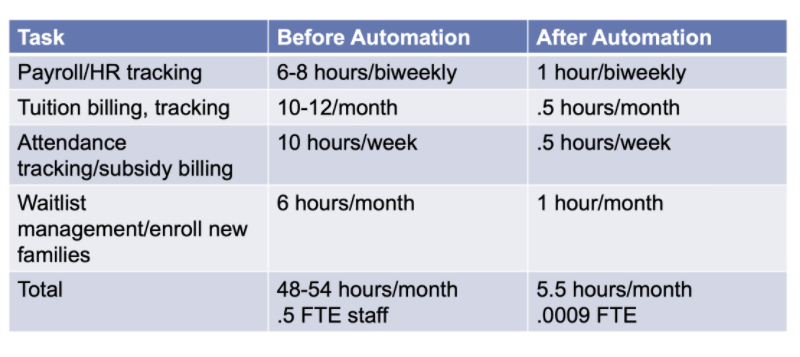
Two of the biggest challenges facing child care businesses, according to Louise Stoney and Sharon Easterling of Opportunities Exchange, is having enough time and money to operate successfully.
In Early Childhood Investigations’ latest webinar, Louise and Sharon provided a comprehensive overview of how child care management software (CCMS) can address those two challenges by giving centers a way to automate their business operations, thereby freeing up time to focus on what they love – spending time with the children in their care.
“The childcare business model is challenging,” said Louise. “Market-based pricing doesn’t cover the full cost of care – especially if you serve infants and toddlers – and small centers with fewer than 100 children are struggling to break even.”
The way business automation can help child care centers is fourfold:
- Save time: Automating operations greatly reduces the amount of staff time needed.
- Save money: Reduced labor translates to cost savings for administrative tasks.
- Increase revenue: Automated payments reduce bad debt, ease reconciliation of subsidy reimbursement, etc.
- Skilled financial management: Data is available in electronic format, which can be analyzed to inform financial decisions.
Get a demo of how child care management software can streamline your operations.
“Directors want to focus on educational leadership, but the administrative demands of their job tend to take a larger share of their time,” said Sharon. “With more streamlined operations and skilled financial management, directors can shift the balance of their activities to favor time with children, families and staff.”
Louise and Sharon dove into specific challenges child care centers face that drain their time and money. Louise, who has a background in early childhood finance, went over what billing and collections can look like with an electronic payment system.
“In child care, every dollar counts, but centers often feel conflicted collecting tuition while supporting their families at the same time,” said Louise. “With electronic payment systems, invoices are automatically generated and parents manage their payment record, which reduces the need for centers to communicate about non-payments.”
Staff-child ratios has become a bigger issue with the onset of COVID-19. The solution? A staff-child ratio management feature that is often included in CCMS systems. According to Louise and Sharon, many CCMS systems can provide real-time data about staff-child ratios for every classroom in a center’s program. This information can help directors stay on top of staffing needs throughout the day.
Staying full is also a challenge centers are encountering, but CCMS offers tools to help centers address it:
- Data management: Track vacancy rate by classroom each week to drive decision-making. Use the data to understand times of the year when enrollment goes up and down to plan classroom staffing accordingly.
- Enrollment and waitlist management: Leverage automated scheduling tools for tours, track prospects through regular email communication, and automate online tools like applications and tour scheduling to streamline the enrollment process and keep family information in one place.
Louise said part of any child care center’s success is knowing its true cost per child. “Understanding the cost by child and classroom is vital to making good business decisions – you must identify any revenue gaps before you can identify ways to fill it.”
She added using a CCMS that offers electronic recordkeeping (either built-in or available via an add-on) can help determine the cost per child and ultimately any profit or loss you’re incurring.
Another major struggle for child care centers is the ability to adequately compensate their teachers. Sharon said that by instituting business automation, centers can lower their administrative costs, while increasing revenue, therefore maximizing resources for teaching staff.
“It’s important we’re able to find new dollars within our programs that can be redeployed for teacher wages, and business automation helps make that possible,” Sharon said.
Additional challenges CCMS can help tackle include family communication and staff management.
- Family communication: With a parent engagement tool, centers can support teachers’ ability to easily communicate with families via email or text, allowing for sharing of photos and videos. In addition, the tools enable messages to be sent to individual families, families within a specific classroom or center-wide.
- Staff management: HR management tools allow centers to keep personnel files up-to-date electronically, automate and track staff sign-in/out (which transfer to a payroll service), electronically record staff tasks and track personnel across multiple locations, if necessary.
When asked about costs of CCMS services, Louise said it’s important to not let the cost of the system be the sole determining factor in your decision. “Nine times out of 10, the product will pay for itself if it’s solving the problems you need it to solve.”
Sharon added it’s important to remember the time savings the systems offer, as time saved is also money saved. She provided the following chart, which estimates time saved by CCMS, categorized by different administrative categories:

To learn more about how child care management software can help create more efficiencies in your child care business, you can view the webinar here.



